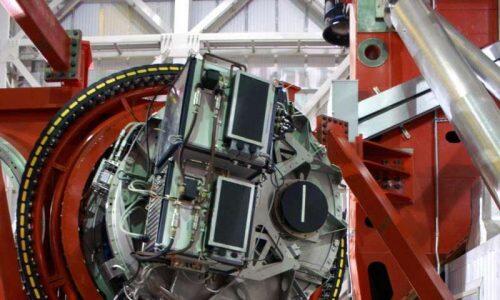After a ten-year design and construction period, a new universal device for astronomical observation at the world’s largest single telescope, the Large Binocular Telescope in Arizona (USA) has been finalised and tested successfully. The highly complex instrument named LUCI allows astronomers to record images and spectra in the infrared with outstanding quality.
It was developed by researchers of the Centre for Astronomy of Heidelberg University (ZAH) in cooperation with colleagues from the Max Planck Institute for Astronomy in Heidelberg and the Max Planck Institute for Extraterrestrial Physics in Garching. The measuring system will undergo further calibrations in the coming weeks. Once they are complete, LUCI will be available to astronomers for regular observation activities. Researchers hope that the data collected with the new instrument will give them an insight into the “nursery” of stars and even allow them to observe planets that circle remote suns.
Located at an altitude of 3,200 metres on Mount Graham in Arizona, the Large Binocular Telescope (LBT) is equipped with two mirrors of 8.4 metres diameter attached to a single mount. The LBT has the light-collecting power of a twelve-metre telescope, making it the largest single telescope in the world. To tap its full potential, astrophysicists and engineers are developing special measuring instruments, one of which is LUCI; the abbreviation stands for “Large Binocular Telescope Near-infrared Utility with Camera and Integral Field”. The universal device can take infrared pictures of a sky region and break up the light emitted by individual objects into its spectral components, as Dr Walter Seifert explains. The scientist at the State Observatory Königstuhl, which belongs to the ZAH, was involved in LUCI’s development from the very start.
Researchers assumed that the LBT would be able to provide much sharper images than the Hubble space telescope. However, for a long time that was not the case, as turbulences in the earth’s atmosphere – the same ones that make the stars appear to “twinkle” – blur images of stars and galaxies to a considerable extent. A new technology with a secondary mirror, known as adaptive optics, makes it possible to compensate for this effect at the Large Binocular Telescope. Five years ago the LBT delivered the first super-sharp images with a test camera. Now this quality can also be achieved with the complex measuring system LUCI, even though the light emanating from the objects must pass numerous lenses and mirrors before the detector registers the cosmic signal. The entire optic assembly is housed in a so-called cryostat which cools LUCI’s components to minus 200 degrees Celsius. “This is a necessary step to prevent undesired infrared heat radiation from LUCI’s components that would otherwise outshine the extremely weak infrared light of the observed astronomical objects,” explains Prof. Dr Jochen Heidt of the State Observatory Königstuhl.
The LUCI spectrograph after its installation at the telescope. Its main components are hidden in a large cryostat tank behind the two black electronics boxes in the foreground. Credit: State Observatory Königstuhl.
Read more at: http://phys.org/news/2016-04-sharp-goodsuccessful-astronomical-instrument-luci.html#jCp












